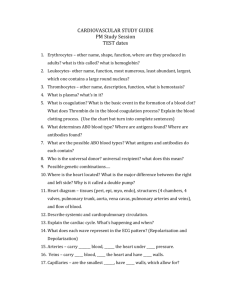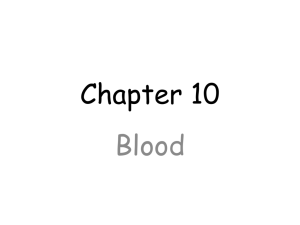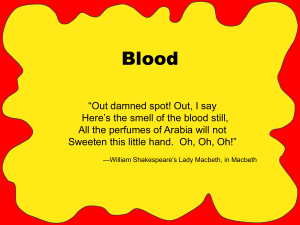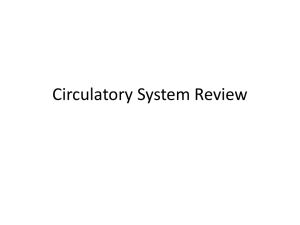Transport IRP
advertisement
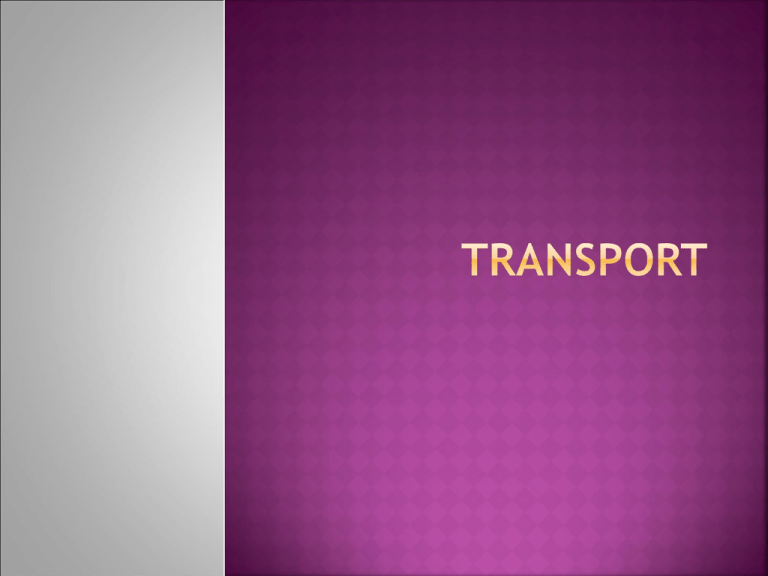
Transport 1. 2. has 2 aspects: Absorption of materials into cells- Occurs over selectively permeable cell membrane. Circulation of the absorbed materials. 1. Passive Transport- “diffusion” No energy (ATP) needed to transport materials over cell membrane. Molecules (gases, Kool-Aid, anything) move from an area of HIGH concentration to an area of LOW concentration until a balance of molecules is reached. Diffusion of water = Osmosis When the solution that surrounds a cell has less water than the cell (ex: salt water), water will leave the cell! The cell will shrivel/dehydrate! When the solution that surrounds a cell has more water than the cell (ex: fresh water), water enters the cell! Cell will swell and could burst! When the solution that surrounds the cell has the same amount of water as the cell……Nothing Happens! Plasmolysis and Turgor Pressure What do you think would happen to Gummy Bears if we placed them in salt water? In distilled water? Energy (ATP) is needed to get materials across the cell membrane. Sometimes, materials are too big to just passively fit through the membrane. Molecules move from LOW concentration to HIGH concentration. Also when cells use energy to engulf things: phagocytosis- ex: when a paramecium eats amoeba or when WBC engulfs/eats bacteria or viruses. Ameba Eating Paramecium Paramecium Circulation 1. 2. in the human body has 2 parts: Absorption- Just like a sponge absorbs, so does our bloodstream. Our blood absorbs nutrients, oxygen, and wastes from EVERY CELL of our body. Transport- Our blood then moves (transports) these nutrients, oxygen, and wastes to where they need to go. Travels through closed vessels Delivers oxygen and nutrients to cells Picks up Carbon Dioxide and wastes from lysosomes and vacuoles Is a tissue (group of cells working together) 1. Plasma- liquid part of the blood that all the other blood cells float in Made mostly of water Carries wastes, nutrients, hormones, and some carbon dioxide 2. Platelets Help clot blood Help heal cuts, prevent us from bleeding to death! Help heal broken blood vessels inside our bodies (bruises) Smallest blood cell (only part of a cell) Shaped like little plates Platelets Video 3. Red Blood Cells (RBC’s) Have no nucleus Produced in bone marrow Contain hemoglobin which carries oxygen 4. White Blood Cells (WBC’s) Fight off bacteria, infections, and germs by engulfing (eating) them (phagocytosis) or by producing antibodies that fight disease. Increase in number during an infection Largest blood cells. Leukemia- when there are too many WBC’s (“cancer of the blood”) Anemia- not enough RBC’s, therefore, not enough hemoglobin. Low hemoglobin means low oxygen levels, so the person will be very TIRED! Sickle Cell Anemia- when RBC’s become shaped like a crescent, cannot carry enough oxygen, so the person is tired and feels pain Sickle Cell Video There are 4 types of blood: A, B, AB, & O Blood is named for the antigens that are present on RBC’s. (Antigens=anything that your body sees as foreign). Blood Type Antigen on RBC (Enemy) Antibodies in plasma (Attackers) A A Anti-B B B AB A&B Anti-A Neither O None Both Anti-A & Anti-B Type O is the “universal donor” because there are no antigens to be seen as foreign) The AB is the “universal recipient” because it doesn’t have antibodies to attack anything. When doctors do a blood transfusion, they need to be sure that the person they are giving blood to (recipient) does not have any antibodies that would attack the blood donor’s antigens (causes clumping which leads to DEATH). Blood Type Can Donate To A A, AB Can Receive From A, O B B, AB B, O AB AB A, B, AB, O O A, B, AB, O O Designed to protect our body against: Antigens- anything our body sees as foreign (virus, bacteria, pollen if you have allergies) and produces antibodies against. Pathogen- Anything that causes disease (virus, bacteria). Immunity- the accumulation of antibodies that enable our body to resist disease. Antibody- protein in the blood that detects and destroys antigens. Active- When your body “actively” fights an antigen. Occurs when you get the disease (like catching a cold) OR when you get a vaccination (Vaccination= an injection of a dead or weakened virus/disease. This alarms your WBC’s to produce antibodies.) Once your body has produced antibodies for a disease/virus, every time you come in contact with the disease/virus, your WBC’s recognize the disease and automatically produce antibodies that will kill the invader. Phagocytes- WBC’s that engulf germs Lymphocytes- WBC’s that produce antibodies When your body “passively” gets immunity, occurs when: Antibodies are injected (rare) Babies receive mother’s antibodies while in the uterus or through breastmilk. Video #11: Immune System Can be brought on by reactions to nonharmful things like pollen, dust, pet hair. Occurs when your body sees these things as antigens and produces antibodies. Because there are no real harmful substances present, the antibodies have nothing to fight. Antibodies make a chemical called histamine (causes sneezing, runny nose, watery eyes). Medications containing antihistamines help. Blood is transported in blood vessels. There are three types: Arteries Veins Capillaries Biggest, thickest, blood vessel Carry blood away from heart Feel the pulse in your artery (because the blood is under the most pressure in an artery) Largest artery is the aorta. Smaller than arteries but bigger than capillaries Carry blood to the heart The largest vein is the vena cava. Have valves to prevent the backflow of blood. Capillary video clip Smallest blood vessel, 1 cell thick. Connect arteries to veins Site of DIFFUSION of materials between the blood and our body cells because they’re so thin! The HEART! The pumping organ First we’ll travel to the: Vena Cava- A vein that brings deoxygenated blood from the body to the heart. This vein leads directly into the right atrium. Right Atrium- Upper chamber of the heart. Receives deoxygenated blood from the body. Valve- Between atrium and ventricles. Prevents backflow of blood. Right Ventricle- sends all of this deoxygenated blood to the lungs. Pulmonary Artery- takes the deoxygenated blood away from the heart to the lungs to be “cleaned.” Lungs- here, the blood dumps its carbon dioxide and picks up oxygen in the microscopic lung structure of the alveoli. Pulmonary Vein- takes oxygenated blood to the heart from the lungs (clean blood) so the heart can pump it through the body. Pulmonary Valve, Tricuspid Valve “Pump your Blood” song Left Atrium- Receives oxygenated blood from the lungs. Valve Left Ventricle- sends oxygenated blood to the body through the aorta. Aorta- largest artery, takes oxygenated blood from the heart to all parts of the body. Septum- separates left and right sides of the heart, keeps oxygenated and non-oxygenated blood separate. High Blood Pressure: When there’s too much pressure on your arteries Can damage your heart because it has to pump too hard Can damage your arteries Caused by stress, poor diet, heredity, smoking, and aging When the heart doesn’t get enough oxygen and it “suffocates.” Can damage the heart Can lead to death Same causes as high blood pressure Mammalian Bill Nye Heart
